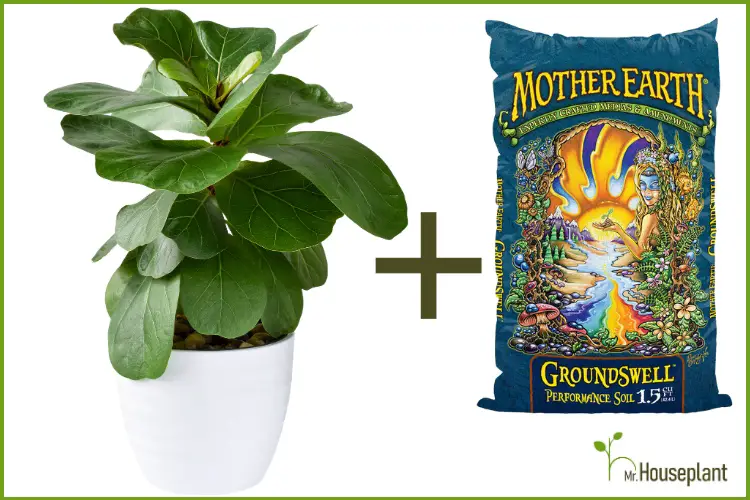
Some potting soils dry out too fast depriving your plant of water. But others may retain too much moisture. The following text will tell you all about the best potting soil for a Fiddle Leaf Fig.
The best potting mix for a Fiddle Leaf Fig is a mix that’s well-draining and porous. It has a soil pH between 5.5 and 7.0. The mix with optimal physical and chemical properties contains enough macropores with oxygen. This helps roots grow healthy. Fiddle Leaf Fig plants dislike staying wet for extended periods. So dense soil that retains too much water is not a good choice. Poor aeration and drainage are the least ideal for your Fiddle Leaf Fig tree. You want to avoid poor performance potting mix. Otherwise, your plant’s health may be affected. You may also need to replant it again.
So what is the best potting soil for a Fiddle Leaf Fig? There are potting soil mixes of various qualities available. But not all are suitable for your Fiddle Leaf Fig plants. One of the best mixes to choose for your Leaf Fig is Mother Earth Groundswell Performance Soil. This is an all-purpose potting soil. It contains ingredients such as peat moss, perlite, pumice, and worm castings. It also has some aged forest products, guanos, and meals. These ingredients provide great aeration to your Leaf Fig.
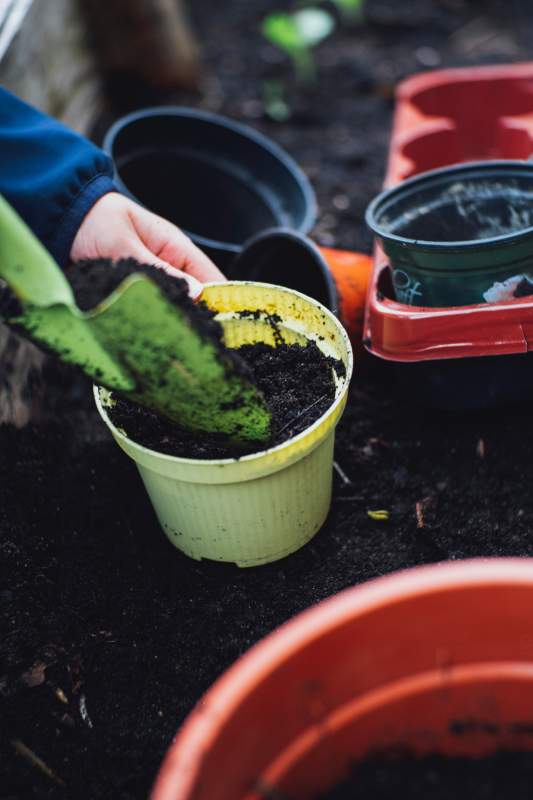
Soil and potting tools
A quick recap of the best potting soil for a Fiddle Leaf Fig:
- Good aeration
- Proper drainage
- Right density and porosity
- Enough nutrients.
What Is The Best Potting Soil Mix Recipe For A Fiddle Leaf Fig?
The best potting soil mix recipe for a Fiddle Leaf Fig contains the following items:
- 2 parts regular potting soil
- 1 part perlite
- 1 part bark/pumice/vermiculite/another amendment.
Just mix them all together and you’re good to go. Making a homemade potting mix may look tricky at first. But it’s actually quite simple. You just need to combine all ingredients together. Remember to stick to the right amounts.
Making homemade potting media takes longer than buying pre made potting mixes. But it’s certainly beneficial. It gives you the opportunity to make a unique blend. A blend perfect for your plant species, size, and specific environment. You can control the proportions and types of ingredients. You can play around until you come up with just the right combination. You’re missing the opportunity to customize a potting mix when you use a commercial mix. Making your own mix will let you meet the unique needs of your plant.
Here is the video on how to make your own soil mix:
Can I Use Regular Potting Soil For Fiddle Leaf Fig?
Yes, you can use regular potting soil for Fiddle Leaf Figs. You should always add other materials to it. Use perlite, bark, vermiculite, or another ingredient. It will help you improve drainage and air holding capacity. Most regular potting soils won’t meet fiddle leaf figs root requirements for oxygen. Avoid using general-purpose, pre-mixed soils alone for Fiddle Leaf Fig trees.
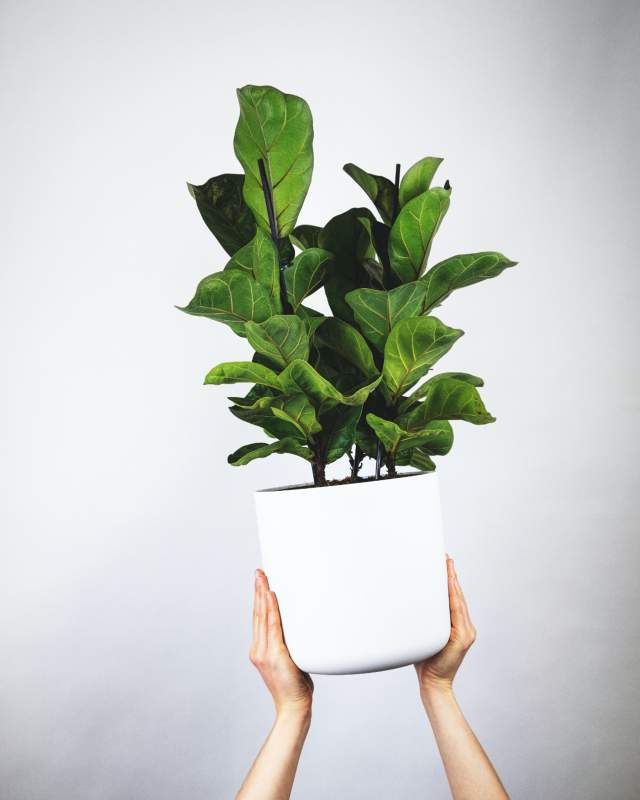
Ficus tree in the pot
Can I Use Succulent Soil For Fiddle Leaf Fig?
Yes, you can use succulent soil for Fiddle Leaf Figs. But you may need to water it more frequently. No need to worry about this if you make your own mix or buy Mother Earth Soil. Succulent soil mixes dry out pretty fast so this may work well for Fiddle Leaf Figs too. However, consider the well-draining quality of the succulent potting mix. It may dry out too fast for a Fiddle Leaf Fig. That’s because soil characteristics may greatly vary depending on the manufacturer. Soil mixes dry out at different speeds from one brand to another.
Can I Use Cactus Soil For Fiddle Leaf Fig?
Yes, you can use cactus soil for Fiddle Leaf Fig trees. However, this fast-drying soil almost certainly requires you to water more often. Being a succulent, cactus enjoys well draining potting soil. But how fast the soil dries out widely varies depending on the brand. Some manufacturers offer cactus potting mixes that are extremely fast-draining. If you choose soil of this kind, your Fiddle Leaf Fig may not get enough water. Wrong soil can seriously harm your plant. Make sure to observe your Fiddle Leaf Fig tree closely. Increase the frequency of watering if necessary.
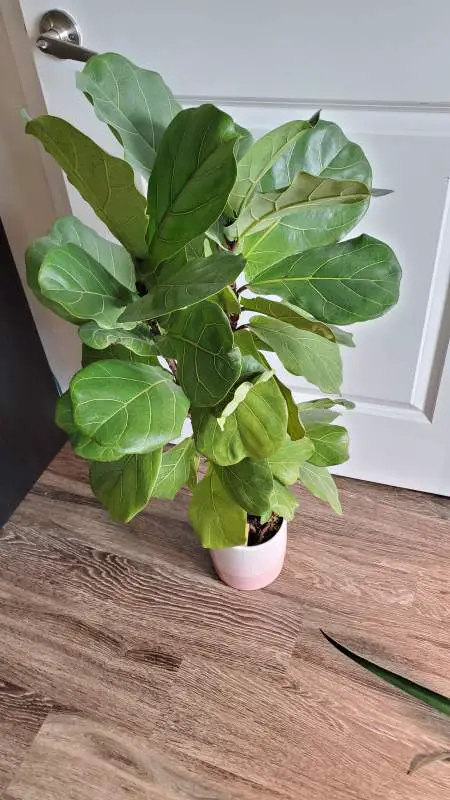
One of my Fiddle Leaf Fig trees
Is Pumice Good For Fiddle Leaf Fig?
Yes, pumice is good for Fiddle Leaf Figs, due to the following benefits:
- lightens the soil
- increases porosity of the soil
- improves aeration and drainage
- reduces negative effects in case the soil cracks, shrinks, etc.
- easily accessible thanks to many pumice deposits around the world.
Pumice is a very lightweight porous rock. It gets formed during volcanic eruptions. Its physical and chemical properties make it widely used for horticultural media.
Keep in mind that pumice is an inorganic amendment. You won’t be adding any nutrients to your Fiddle Leaf Fig soil by amending it with pumice. But that’s just fine – adding nutrients is not the goal here. It will assist you with drainage and aeration. Both are extremely important for plant’s root health. If your Fiddle Leaf Fig doesn’t have proper drainage, you may notice root rot. An easy fix is to add pumice. It will help you get well-draining soil.
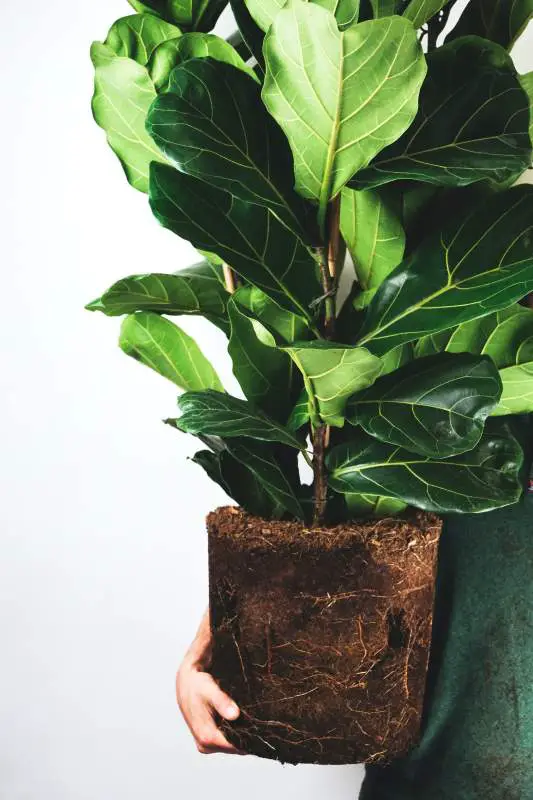
Ficus Lyrata in soil
Is Vermiculite Good For Fiddle Leaf Fig?
Yes, vermiculite is good for Fiddle Leaf Figs. These are some of its characteristics and benefits:
- increases soil porosity
- helps hold water and fertilizer in the potting soil
- near-neutral pH
- contains some calcium and magnesium.
This clay mineral is another lightweight addition to the best potting soil for a Fiddle Leaf Fig. It is a highly versatile material that comes in different grades. The coarse grade is more suitable for a Fiddle Leaf Fig. Make sure you only use horticultural-grade vermiculite for Fiddle Leaf Fig potting mix. The reason is that other grades don’t necessarily exclude toxic contaminants.
Yours Truly,


Related Posts
How To Repot A Spider Plant: How & When
How to Repot a Fiddle Leaf Fig?
How To Repot a Houseplant? (VITAL For Plant Health)